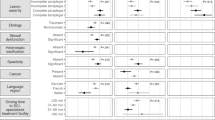Abstract
Introduction
Women with spinal cord injury (SCI) and who develop breast cancer are a vulnerable and potentially overlooked population. They experience risk factors owing to decreased mobility and are at risk for unique complications from their oncologic treatment.
Case presentation
A 54-year-old woman who suffered a T6 AIS A traumatic SCI in 1981, who was diagnosed 32 years later with estrogen receptor and progesterone receptor positive and human epidermal growth factor receptor 2-negative invasive ductal carcinoma. During the course of her chemotherapy, she experienced several complications, including reflexive diaphoresis, urinary tract infection, leukopenia, anemia, dehydration, and weakness. These contributed to the development of a stage 4 ischial pressure sore, which required complex treatment.
Discussion
There is a paucity of literature examining the complications of chemotherapy that may be unique to those with SCI. Physiatrists will be seeing more women undergoing oncologic care, as this population of patients ages. A multidisciplinary approach that takes into account the pathophysiologic changes associated with SCI is crucial to understand and prevent complications that could affect their outcomes and contribute to increased cost in a value-based health-care system.
Similar content being viewed by others
Log in or create a free account to read this content
Gain free access to this article, as well as selected content from this journal and more on nature.com
or
References
Spinal Cord Injury Facts and Figures at a Glance. National Spinal Cord Injury Statistical Center. 2016. https://www.nscisc.uab.edu/Public/Facts%202016.pdf (accessed 4 March 2018).
Mccoll M. A house of cards: women, aging and spinal cord injury. Spinal Cord. 2002;40:371–73.
Howlader N, Noone AM, Krapcho M, Miller D, Bishop K, Kosary CL. SEER Cancer Statistics Review (CSR), 1975-2014. Surveillance, Epidemiology, and End Results Program. 2016. https://seer.cancer.gov/csr/1975_2014/ (accessed 4 March 2018).
Graham A, Savic G, Gardner B. Cervical and breast cancer screening in wheelchair dependent females. Spinal Cord. 1998;36:340–44.
Nosek MA,Howland CA, Breast and cervical cancer screening among women with physical disabilities. Arch Phys Med Rehabil. 1997;78:S39–44.
Iezzoni LI, Park ER, Kilbridge KL. Implications of mobility impairment on the diagnosis and treatment of breast cancer. J Women’s Health. 2011;20:45–2.
Are we ready for this change? Preventing pressure ulcers in hospitals. Agency for Healthcare Research and Quality. 2014. https://www.ahrq.gov/professionals/systems/hospital/pressureulcertoolkit/putool1.html (accessed 4 March 2018).
Kruger EA, Pires M, Ngann Y, Sterling M, Rubayi S. Comprehensive management of pressure ulcers in spinal cord injury: current concepts and future trends. J Spinal Cord Med. 2013;36:572–85.
Duckworth WC, Solomon SS, Jallepalli P, Heckemeyer C, Finnern J, Powers A. Glucose intolerance due to insulin resistance in patients with spinal cord injuries. Diabetes. 1980;29:906–10.
Byrne DW, Salzberg CA. Major risk factors for pressure ulcers in the spinal cord disabled: a literature review. Spinal Cord. 1996;34:255–63.
Paik S, Shak S, Tang G, et al. A multigene assay to predict recurrence of tamoxifen-treated, node-negative breast cancer. N Engl J Med. 2004;351:2817–26.
Paik S, Tang G, Shak S, et al. Gene expression and benefit of chemotherapy in women with node-negative, estrogen receptor-positive breast cancer. J Clin Oncol. 2006;24:3726–34.
Albain KS, Barlow WE, Shak S, et al. Prognostic and predictive value of the 21-gene recurrence score assay in postmenopausal women with node-positive, oestrogen-receptor-positive breast cancer on chemotherapy: a retrospective analysis of a randomised trial. Lancet Oncol. 2010;11:55–6.
NPUAP pressure injury stages. National Pressure Ulcer Advisory Panel. 2016. http://www.npuap.org/resources/educational-and-clinical-resources/npuap-pressure-injury-stages (accessed: 4 March 2018).
DeLisa JA, Frontera WR. Physical medicine & rehabilitation: principles and practice. Philadelphia: Lippincott Williams & Wilkins Health; 2010.
Bates-Jensen BM, Guihan M, Garber SL, Chin AS, Burns SP. Characteristics of recurrent pressure ulcers in veterans with spinal cord injury. J Spinal Cord Med. 2009;32:34–2.
Rappl LM. Physiological changes in tissues denervated by spinal cord injury tissues and possible effects on wound healing. Int Wound J. 2008;5:435–44.
Guttman L. Spinal cord injuries: comprehensive management and research. Oxford, UK: Blackwell Scientific Ltd; 1976.
Lindan R, Joiner E, Freehafer AA, Hazel C. Incidence and clinical features of autonomic dysreflexia in patients with spinal cord injury. Spinal Cord. 1980;18:285–92.
Mathias CJ, Christensen NJ, Corbett JL, Frankel HL, Goodwins TJ, Peart WS. Plasma catecholamines, plasma renin activity and plasma aldosterone in tetraplegic man, horizontal and tilted. Clin Sci. 1975;49:291–99.
Crane D, Hall B. Pressure ulcers can wreck your life! Preventing and managing skin problems after SCI. 2018. http://sci.washington.edu/info/forums/reports/pressure_ulcers_2012.asp (accessed 4 March 2018).
Guo S, DiPietro LA. Factors affecting wound healing. J Dent Res. 2010;89:219–29.
Krause JS, Broderick L. Patterns of recurrent pressure ulcers after spinal cord injury: identification of risk and protective factors 5 or more years after onset. Arch Phys Med Rehabil. 2004;85:1257–64.
Fast A. Reflex sweating in patients with spinal cord injury: a review. Arch Phys Med Rehabil. 1977;58:435–37.
Keller P, Wille J, Ramshorst BV, Werken CVD. Pressure ulcers in intensive care patients: a review of risks and prevention. Intensive Care Med. 2002;28:1379–88.
Regan MA, Teasell RW, Wolfe DL, Keast D, Mortenson WB, Aubut J-AL. A systematic review of therapeutic interventions for pressure ulcers after spinal cord injury. Arch Phys Med Rehabil. 2009;90:213–31.
Stillman MD, Williams SR. A piece of my mind. It’s rough out there for us. JAMA. 2016;31:585–86.
Funding
This research received no specific grant from any funding agency in the public, commercial, or not-for-profit sectors.
Author information
Authors and Affiliations
Corresponding author
Ethics declarations
Conflict of interest
The authors declare that they have no conflict of interest.
Rights and permissions
About this article
Cite this article
de Padua, A.L., Strickland, K., Patrick, M. et al. Spinal cord injured women’s treatment of breast carcinoma: alert to complications. Spinal Cord Ser Cases 4, 46 (2018). https://doi.org/10.1038/s41394-018-0079-2
Received:
Revised:
Accepted:
Published:
DOI: https://doi.org/10.1038/s41394-018-0079-2



